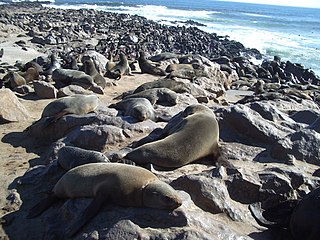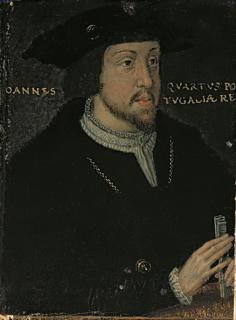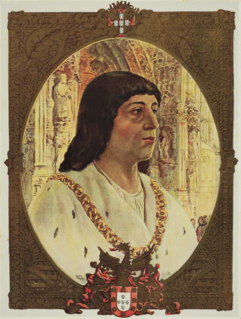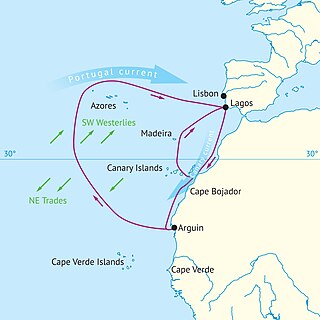 W
WThe history of the Kingdom of Portugal from the Illustrious Generation of the early 15th century to the fall of the House of Aviz in the late 16th century has been named the "Portuguese golden age" and the "Portuguese Renaissance". During this period, Portugal was the first European power to begin building a colonial empire as Portuguese sailors and explorers discovered an eastern route to India as well as several Atlantic archipelagos and colonized the African coast and Brazil. They also explored the Indian Ocean and established trading routes throughout most of southern Asia, sending the first direct European maritime trade and diplomatic missions to Ming China and to Japan. The Portuguese Renaissance produced a plethora of poets, historians, critics, theologians, and moralists. The Cancioneiro Geral by Garcia de Resende is taken to mark the transition from Old Portuguese to the modern Portuguese language.
 W
WPortuguese discoveries are the numerous territories and maritime routes recorded by the Portuguese as a result of their intensive maritime exploration during the 15th and 16th centuries. Portuguese sailors were at the vanguard of European overseas exploration, chronicling and mapping the coasts of Africa, Canada, Asia, and Brazil, in what became known as the Age of Discovery. Methodical expeditions started in 1419 along West Africa's coast under the sponsorship of prince Henry the Navigator, with Bartolomeu Dias reaching the Cape of Good Hope and entering the Indian Ocean in 1488. Ten years later, in 1498, Vasco da Gama led the first fleet around Africa to India, arriving in Calicut and starting a maritime route from Portugal to India. Portuguese explorations then proceeded to southeast Asia, where they reached Japan in 1542, forty-four years after their first arrival in India. In 1500, the Portuguese nobleman Pedro Álvares Cabral became the first European to discover Brazil.
 W
WThe Second Portuguese India Armada was assembled in 1500 on the order of King Manuel I of Portugal and placed under the command of Pedro Álvares Cabral. Cabral's armada famously discovered Brazil for the Portuguese crown along the way. By and large, the Second Armada's diplomatic mission to India failed, and provoked the opening of hostilities between the Kingdom of Portugal and the feudal city-state of Calicut. Nonetheless, it managed to establish a factory in the nearby Kingdom of Cochin, the first Portuguese factory in Asia.
 W
WAfonso V, known by the sobriquet the African, was King of Portugal. His sobriquet refers to his conquests in Northern Africa.
 W
WJoão de Barros, called the Portuguese Livy, is one of the first great Portuguese historians, most famous for his Décadas da Ásia, a history of the Portuguese in India, Asia, and southeast Africa.
 W
WBeyond Capricorn: How Portuguese adventurers secretly discovered and mapped Australia and New Zealand 250 years before Captain Cook is a 2007 book by journalist Peter Trickett on the theory of Portuguese discovery of Australia. Although its thesis is similar to that advanced by Kenneth McIntyre in 1977, Lawrence Fitzgerald in 1984 and others, the publisher and some news reports presented it as being a new theory on the discovery of Australia.
 W
WThe Cantino planisphere or Cantino world map is a manuscript Portuguese world map preserved at the Biblioteca Estense in Modena, Italy. It is named after Alberto Cantino, an agent for the Duke of Ferrara, who successfully smuggled it from Portugal to Italy in 1502. It measures 220 x 105 cm.
 W
WCape Cross is a small headland in the South Atlantic in Skeleton Coast, western Namibia, on the C34 highway some 60 kilometres north of Hentiesbaai and 120 km north of Swakopmund on the west coast of Namibia.
 W
WFernão Lopes de Castanheda was a Portuguese historian in the early Renaissance. His "History of the discovery and conquest of India", full of geographic and ethnographic objective information, was widely translated throughout Europe.
 W
WConquistadors were the knights, soldiers and explorers of the Spanish and the Portuguese Empires. During the Age of Discovery, conquistadors sailed beyond Europe to the Americas, Oceania, Africa, and Asia, conquering territory and opening trade routes. They brought colonialism to much of the world for Spain and Portugal in the 16th, 17th, and 18th centuries.
 W
WAntónio Galvão, also known as Antonio Galvano, was a Portuguese soldier, chronicler and administrator in the Maluku islands, and a Renaissance historian who was the first person to present a comprehensive report of the leading voyages and explorers up to 1550 by Portuguese explorers and those of other nationalities. His works, especially the Treaty of Discovery that was published in Lisbon in 1563 and in English by Richard Hakluyt in 1601, are notably accurate.
 W
WGaspar Vilela or Gaspar Villela, was a priest and Jesuit missionary, and his activity in Japan influenced the Portuguese and Christian presence.
 W
WThe Hermitage of Our Lady of Guadalupe, also known as the Chapel of Our Lady of Guadalupe is located between the towns of Budens and Raposeira, in the Municipality of Vila do Bispo, Faro District in the Algarve region of Portugal. It is particularly well-known as a supposed location where the pioneer navigator Prince Henry the Navigator (1394-1460) used to pray. In addition to a chapel, there is a small museum dedicated to Prince Henry.
 W
WThe history of the Kingdom of Portugal from the Illustrious Generation of the early 15th century to the fall of the House of Aviz in the late 16th century has been named the "Portuguese golden age" and the "Portuguese Renaissance". During this period, Portugal was the first European power to begin building a colonial empire as Portuguese sailors and explorers discovered an eastern route to India as well as several Atlantic archipelagos and colonized the African coast and Brazil. They also explored the Indian Ocean and established trading routes throughout most of southern Asia, sending the first direct European maritime trade and diplomatic missions to Ming China and to Japan. The Portuguese Renaissance produced a plethora of poets, historians, critics, theologians, and moralists. The Cancioneiro Geral by Garcia de Resende is taken to mark the transition from Old Portuguese to the modern Portuguese language.
 W
WThe Japan voyage was a trade route established by the Portuguese from 1550 to 1639 linking Goa, then capital of the Portuguese India, to Japan. This lucrative annual trip was carried out under monopoly of the Portuguese crown, and was in charge of a Captain general. The charge of Captain general of the Japan's trip was officially attributed by the governor of Portuguese India as a reward for services rendered. The large ships involved in this trade were referred to as the nau do trato, the silver ships, China's ships, and became known among the Japanese as Kurofune, a term that came to be used to name all Western ships that supplied in Japan during the Edo period.
 W
WJohn II, called the Perfect Prince, was King of Portugal from 1481 until his death in 1495, and also for a brief time in 1477. He is known for re-establishing the power of the Portuguese monarchy, reinvigorating the Portuguese economy, and renewing his country's exploration of Africa and the Orient.
 W
WManuel I, known as the Fortunate, was King of Portugal from 1495 to 1521. A member of the House of Aviz, Manuel was Duke of Beja and Viseu prior to succeeding his cousin, John II of Portugal, as monarch. Manuel ruled over a period of intensive expansion of the Portuguese Empire owing to the numerous Portuguese discoveries made during his reign. His sponsorship of Vasco da Gama led to the Portuguese discovery of the sea route to India in 1498, resulting in the creation of the Portuguese India Armadas, which guaranteed Portugal's monopoly on the spice trade. Manuel began the Portuguese colonization of the Americas and Portuguese India, and oversaw the establishment of a vast trade empire across Africa and Asia.
 W
WThe Nanban trade or Nanban trade period , was a period in the history of Japan from the arrival of Europeans in 1543 to the first Sakoku Seclusion Edicts of isolationism in 1614.
 W
WDom Henrique of Portugal, Duke of Viseu, better known as Prince Henry the Navigator, was a central figure in the early days of the Portuguese Empire and in the 15th-century European maritime discoveries and maritime expansion. Through his administrative direction, he is regarded as the main initiator of what would be known as the Age of Discovery. Henry was the fourth child of the Portuguese king John I, who founded the House of Aviz.
 W
WPedro Nunes was a Portuguese mathematician, cosmographer, and professor, from a New Christian family.
 W
WA padrão is a stone pillar left by Portuguese maritime explorers in the 15th- and 16th-centuries to record significant landfalls and thereby establish primacy and possession. They were often placed on promontories and capes or at the mouths of major rivers. Early markers were simple wooden pillars or crosses but they deteriorated quickly in the tropical climate where they were often erected. Later, padrões were carved from stone in the form of a pillar surmounted by a cross and the royal coat of arms.
 W
WPadrão dos Descobrimentos is a monument on the northern bank of the Tagus River estuary, in the civil parish of Santa Maria de Belém, Lisbon. Located along the river where ships departed to explore and trade with India and the Orient, the monument celebrates the Portuguese Age of Discovery during the 15th and 16th centuries.
 W
WThe Padrão Real was a cartographic work of Portuguese mastery produced secretly and maintained by the organization of the Portuguese Royal Court in the 16th century. The work was available to the scientific elite of the time, being exposed in the Casa da Índia. In the Padrão Real the new discoveries of the Portuguese were constantly added and mapped. The first Padrão Real was produced in the time of Henry the Navigator, even before the existence of the Casa da Índia.
 W
WPortugal was a leading country in the European exploration of the world in the 15th century. The Treaty of Tordesillas in 1494 divided the Earth outside Europe into Castilian and Portuguese global territorial hemispheres for exclusive conquest and colonization. Portugal colonized parts of South America, but also made some unsuccessful attempts to colonize North America.
 W
WThe Portuguese discovery of the sea route to India was the first recorded trip directly from Europe to India, via the Cape of Good Hope. Under the command of Portuguese explorer Vasco da Gama, it was undertaken during the reign of King Manuel I in 1495–1499. Considered one of the most remarkable voyages of the Age of Discovery, it initiated the Portuguese maritime and trade presence in Kerala and the Indian Ocean.
 W
WThe spice trade refers to the trade in spices between historical civilizations in Asia, Northeast Africa and Europe. Spices such as cinnamon, cassia, cardamom, ginger, pepper, and turmeric were known and used in antiquity for commerce in the Eastern World. These spices found their way into the Near East before the beginning of the Christian era, where the true sources of these spices were withheld by the traders and associated with fantastic tales.
 W
WThe Planisphere of Domingos Teixeira was made by this Portuguese cartographer in 1573, during the reign of Sebastian of Portugal.
 W
WThe theory of Portuguese discovery of Australia claims that early Portuguese navigators were the first Europeans to sight Australia between 1521 and 1524, well before the arrival of Dutch navigator Willem Janszoon in 1606 on board the Duyfken who is generally considered to be the first European discoverer. This is based on the following elements:The Dieppe maps, a group of 16th-century French world maps, which depict a large landmass between Indonesia and Antarctica. Labelled as Java la Grande, this land mass carries French, Portuguese, and Gallicized Portuguese placenames, and has been interpreted by some as corresponding to Australia's northwestern and eastern coasts. The presence of Portuguese colonies in Southeast Asia from the early 16th century, particularly Portuguese Timor – approximately 650 kilometres (400 mi) from the Australian coast – c. 1513–1516. Various antiquities found on Australian coastlines, claimed to be relics of early Portuguese voyages to Australia, which are more commonly regarded as evidence of Makassan visit of Northern Australia.
 W
WVolta do mar, volta do mar largo, or volta do largo is a navigational technique perfected by Portuguese navigators during the Age of Discovery in the late fifteenth century, using the dependable phenomenon of the great permanent wind circle, the North Atlantic Gyre. This was a major step in the history of navigation, when an understanding of winds in the age of sail was crucial to success: the European sea empires would never have been established had the Europeans not figured out how the trade winds worked.
 W
WFrancis Xavier (born Francisco de Jasso y Azpilicueta; Latin Franciscus Xaverius; Basque: Frantzisko Xabierkoa; Spanish: Francisco Javier; Portuguese: Francisco Xavier;, venerated as Saint Francis Xavier, was a Navarrese Catholic missionary and saint who was the co-founder of the Society of Jesus.